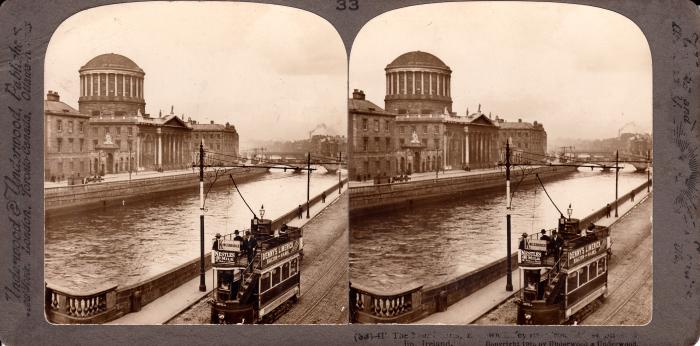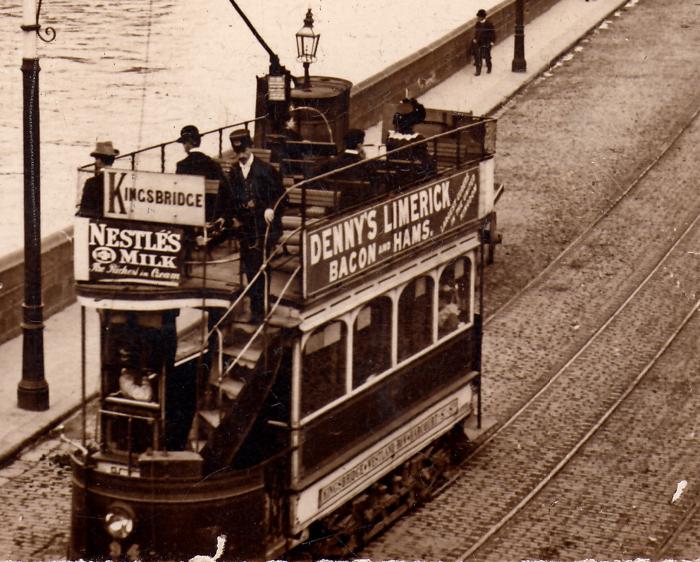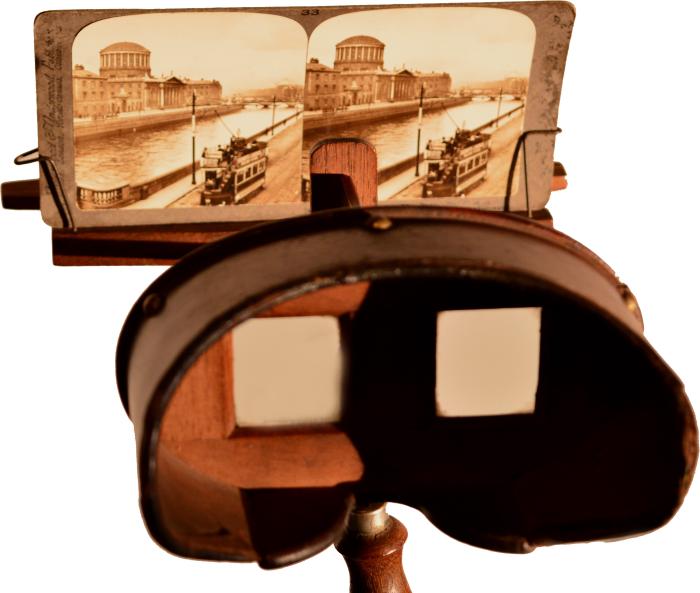Tram 94, Where are You?
By Dr Frank Prendergast, Emeritus Research Fellow, DIT Bolton Street
Luas Cross City—the latest extension to Dublin’s light rail network—opens to passengers on Saturday 9 December 2017. It will carry an additional 10 million passengers per year from St Stephen’s Green to Broombridge, Cabra, in 21 minutes via 13 stops. These summary statistics provided by TII are put into dramatic context and relevance with the recent discovery of a mounted stereo-pair of date-stamped photographs showing a tram travelling towards the city centre in 1903. The viewpoint of the camera is from the upstairs window of a building on the corner of Ussher’s Quay and Lower Bridge Street. The content and history of these high-quality images provide a fascinating insight into Dublin’s public transport system more than a century ago.

Stereo-card No. 33 produced by Underwood & Underwood Publishers showing Tram 94 of the Dublin United Tramways Company travelling towards the city centre on the Kingsbridge to Harcourt Street route in 1903 (Image: Frank Prendergast).
Stereo-card No. 33 from the author’s family collection depicts the tram’s journey along the south side of the River Liffey. The tram shown is proceeding from Kingsbridge railway station (now Heuston Station) to Harcourt Street and is viewed on its inbound journey to the city centre along Merchant's Quay between Whitworth Bridge (now Father Mathew Bridge) and Richmond Bridge (now O’Donovan Rossa Bridge). The poles with white-painted, upper portions denote request stops along the route.
With digital image processing of the original imagery, enlargement shows detail which is not apparent to the unaided eye. In the close-up below, for example, the route terminals (Kingsbridge, Westland Row, and Harcourt Street) are shown on the lower side of the tram close to track level. The number of the tram is 94 and is located beneath the rear headlamp. Tram 94 was put into service at the beginning of 1903. It had 25 downstairs (‘inside’) seats and 29 upstairs (‘outside’) seats. The body was built by Browne of Brunswick Street, an eminent coach company, but the running gear was manufactured elsewhere.
The photographs must have been taken in early 1903, at the latest, particularly given the placard on the end of the upper deck reading Kingsbridge. The method for displaying the terminus names was changed to roller blind displays c. 1903. The trolly and trolly rope connect with the overhead wire providing the operating power supply. The two parallel tram lines which run east–west on either side of the river are paved with high-quality setts with a gauge of 5 feet 23⁄16 inches (1,580 mm).

Close-up detail of Tram 94 and the tramlines (Image: Frank Prendergast).
An examination of the enlarged detail shows the tram conductor at the head of the stairs wearing a uniform featuring a collar and tie, which only came in after the electrification of the tramways. He is also shown wearing the customary aluminium license badge. Fashion in dress is evident too and this, coupled with the apparent emptiness of the streets, could suggest that the photograph was taken on a Sunday. The woman sitting upstairs to the front is wearing a dress with a white-ruffled collar. Stylish hats are worn by all of the men. Below, and to the front, another well-dressed woman passenger is seated facing the river.
The reverse side of the card-mounted photographs provides interesting text describing the location in the early 1900s. The Four Courts, by then more than a century old, is given greatest attention because of its grandeur and construction cost.

Descriptive notes on the reverse of stereo-card No. 33 (Image: Frank Prendergast).
The position of Tram 94 on its route is easily determined on the near contemporary 25-inch Ordnance Survey (OS) map of the city. This delineates inbound and outbound tram tracks on opposite sides of the river. Interestingly, the quays are well provisioned with Electoral Ward boundary stones (B.S.) and OS bench marks (B.M.). The latter give the height of their engraved horizontal lines above the low water datum established by the OS at Poolbeg, Dublin 8 April 1837. It is likely that many of these bench marks still exist.
There are numerous historic images of Dublin’s trams and tramways still in existence in various archives and collections. What makes the content of these stereo-pair photographs unique and important is the location of the scene, the identity number of the tram, the high quality of the photographic images and, especially, the ability to view them as a three-dimensional (3D) image. This was made possible by a 19th-century technological innovation known as a stereoscopic viewer, the specific example discussed here being the Holmes Stereoscopic Viewer.

The Holmes Stereoscopic Viewer and stereo-card No. 33 (Image: Frank Prendergast).
The stereoscopic viewer shown here was originally designed by Oliver Holmes in the United States and consisted of a pair of prismatic lenses fixed in a viewer. The stereo-photographic card is held in a slider which the user can adjust so as to bring the images into focus. Each photograph was taken with two lens spaced several centimetres apart. When viewed as shown, the brain fuses both two-dimensional scenes creating a 3D illusion. Thousands of such cards featuring scenes from around the globe were produced and sold by Underwood & Underwood Publishers and other manufacturers. In their day, they were the precursor of photo-journalism.
As the capital city now celebrates the extension of its most successful public transport system to date, we can proudly reflect on the origins of our tramway system and our public transport heritage. The work of one unnamed photographer is published here and links the past with the present, as does Luas Cross City, joining both sides of the City of Dublin in a new era of transport by tram.
Acknowledgements
I am hugely grateful to Michael Stanley, Emer Dennehy, Mary Deevy, Rónán Swan, Garrett Linnane and James Walsh of TII for their assistance with this article. My gratitude also extends to Clifton Flewitt of the Irish Railway Record Society of Ireland for providing me with a wealth of detail on the history of Dublin’s trams.
(Posted 6 December 2017)